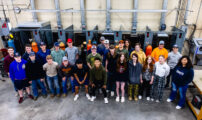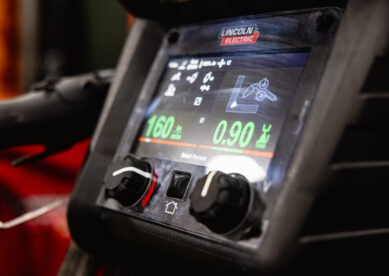GHS Agriculture Students have Industry Credentials Opportunities through Grant
In his role as an agriculture instructor at Gilbert High School, Adam Davis is constantly asking himself one question: What more can I do to prepare my students for the professional world?
After all, there is a high demand for careers in both agriculture and manufacturing in the state of Iowa. Mr. Davis works extensively with students who have incredible technical skills, and many of these students have long-term goals of working in the agriculture industry.
It’s Mr. Davis’s job to help prepare his students for their future careers, and he’s always — always — wanting to do just a little bit more.
He’s taken a big step in an attempt to do just that.
In February, Mr. Davis applied for “Credentials to Careers,” a competitive grant through the Iowa Department of Education (DOE) that was designed to help high school students earn industry-recognized credentials (IRC). And in April, the GHS instructor received the good — no, scratch that, great — news.
The Iowa DOE awarded GHS $138,175 to go toward aiding students in achieving their IRC, whether it be with new equipment purchases or other materials.
“It’s really exciting, and it will totally change what we’re able to offer students,” Mr. Davis said. “The goal is to get kids valuable experiences that make for an easy transition and relevant transition into the workplace, whether that’s working in the trades for the summer, or if they’re interested in going to a technical school, or just pursuing a full-time career.”
In all, the Iowa DOE awarded more than $1.7 million to 20 school districts across the state through the Credentials to Careers program.
A significant portion of the funds GHS received from this grant will go back to the students. For the first time, Gilbert will now be able to offer technical certifications free of cost to the students. And the agriculture education welding program is being recognized as a licensed educational institution through the American Welding Society, which opens the doors to students to earn up to 14 credential opportunities worth more than $7,500.
One piece of equipment students will have the opportunity to work with as a result of the grant is the cutting edge Miller LiveArc Welding Performance Management System. This state-of-the-art piece of equipment allows both novice and advanced students the chance to get a hands-on experience welding through an AI program before they strike the arc. It gives real-time feedback on proper techniques throughout the process. Once students are comfortable, they can begin live welding with the same constant real-time feedback, including a composite score on a scale of 1-100 upon completion of a task.
These new teaching techniques will be invaluable, Davis says.
“I think this is going to be a fantastic bridge because sometimes kids are a little intimidated with things like the sound, the heat, and the sparks,” he said. “With this machine, they can see how they’re going to do with all of those (variables) removed. It’s cutting edge as far as what it’s able to provide … it’s able to tell you things that I can’t actually tell them myself, like structural integrity.”
Mr. Davis consulted with a number of businesses such as M.H. EBY, John Deere, Vermeer Corporation, Lane Trailer Manufacturing, and Sargent Meal Fabricating throughout the grant writing process. He says he knew early on how important it was to become familiar with local connections and their processes and equipment, which will help students to attain their IRCs.
“What we quickly realized is we need to update some things and then also make it industry relevant,” Mr. Davis said. “When our kids go into the workforce, are we providing relevant education for them? Because that’s always the goal.”
GHS Principal Cindy Bassett lauded Davis’s efforts, not only with securing funds from the grant, but for putting the best interests of his students at the forefront of his teaching philosophy.
“This grant leads to more opportunities and experiences in our (agriculture education) department,” Mrs. Bassett said. “Funds will help implement training and equipment to prepare GHS students for a variety of pathways. Thank you to Adam Davis for seeking out ways to grow our program!”
Mr. Davis’s communication with EBY not only helped to serve as a reference for the grant, but it also provided an avenue for the company to play a role in the education of our students. He says EBY has already provided a $15,000 aluminum push-pull welder and buckets of material to practice with. The company is also providing a professional welder to help with individual lessons for students in advanced welding courses.
“That was unexpected, but a very welcomed opportunity,” Mr. Davis said. “The goal is to get kids career opportunities, and what better way than working with kids one on one?”
Let’s end this the way we began with Mr. Davis’s question: What more can I do to prepare my students for the professional world?
Mr. Davis, you have certainly answered your question.



